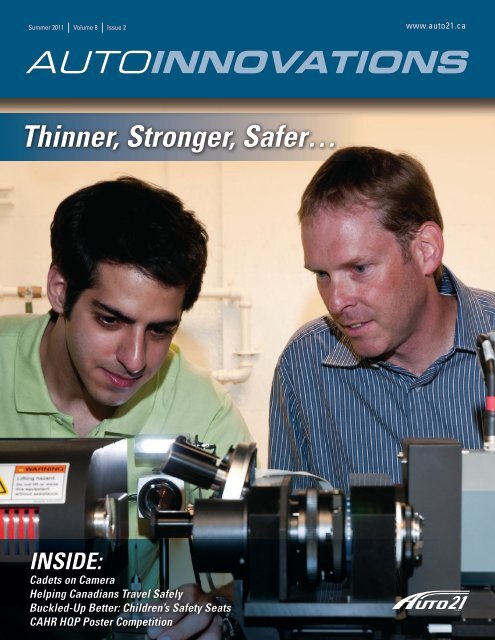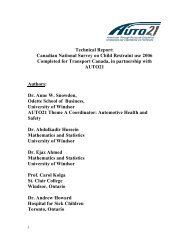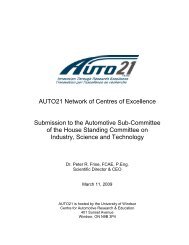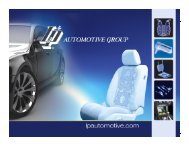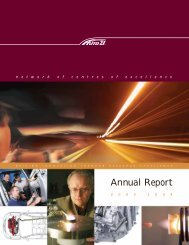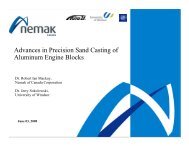Summer 2011 - AUTO21
Summer 2011 - AUTO21
Summer 2011 - AUTO21
- No tags were found...
You also want an ePaper? Increase the reach of your titles
YUMPU automatically turns print PDFs into web optimized ePapers that Google loves.
<strong>Summer</strong> <strong>2011</strong> |Volume 8 |Issue 2www.auto21.caAUTOINNOVATIONSThinner, Stronger, Safer…INSIDE:Cadets on CameraHelping Canadians Travel SafelyBuckled-Up Better: Children’s Safety SeatsCAHR HQP Poster CompetitionInnovation Through Research Excellencel’innovation par l’excellence en recherche
Cadets on CameraWe expect police officers to drive fast to catchcriminals or reach accident sites; we also expectthem to drive safely. In a nutshell, police officershave to drive better than the average Joe, withthe same training tools at their disposal. Thiscould soon change.Since January <strong>2011</strong>, 30 police cadets atFrançois-Xavier Garneau College near QuebecCity have been using specially designedsoftware to help them pass a precision drivingcourse that traditionally has a 30 percent failrate.“These cadets already have their drivinglicences,” says <strong>AUTO21</strong> project leader, DenisLaurendeau, a professor of electrical andcomputer engineering at Université Laval.“And they must pass this course to graduate,so the stakes are high. Our technology can helpimprove the pass-rate by providing better datato cadet and instructor on key elements of eachmanoeuvre.”The technology was originally developed to helpseniors and young drivers improve their skillsas part of <strong>AUTO21</strong>’s project, Safe Platform forEvaluating and Enhancing Driver Qualifications.The original technology uses in-vehicle camerasto record the driver’s cephalo-ocular behaviour,such as checking blind spots and using mirrors,during common driving manoeuvres. Theinstructor later replays the data he collects ona PDA (linked by WiFi to a laptop in the backseat) and the video with the driver to see whereimprovements can be made.“When we retested the senior drivers twoyears later, a significant two-thirds of themhad maintained their improved driving skills,”says project team member, Normand Teasdale,also of Université Laval. “So the technology isproven.”However, project partner CAA-Québecsuggested that it could be adapted to theneeds of police cadets and eventually to thoseof others, such as ambulance drivers and firefighters,who also need top-notch driving skillsfor their jobs. For the police cadets, CAA-Québecspecifically asked for an audio component torecord the instructions and the interactionbetween cadet and instructor.“The instructors wanted more than paper-basednotes and vague recollections to support theirarguments that cadets hadn’t performed somemanoeuvres, especially left-hand turns andmerges, correctly,” explains Dr. Laurendeau.“This is important because the cadets don’tlook at the instructor when the instructions aregiven. Now they can both review hard data onwhat was actually said and done, manoeuvre bymanoeuvre.”Other adaptations include additional camerasfor the driving environment, a GPS, simplifyingthe software interface for non-computer expertsand providing a viewer for cadets to replay themanoeuvres by themselves later.Each cadet drives an instrumented car for twohours, two days a week in the company of aninstructor, practising changing lanes, overtaking,crossing intersections and merging ontohighways. The GPS records their exact locationand speed on the road—this is a precisiondriving course, after all—the instructor entersother relevant data and the audio records, well,everything.“The biggest challenge,” says Dr. Laurendeau,“was adapting the interface for non-computerexperts. The system had to be easy to use andunderstand for driving instructors whose jobis to train students rather that fiddling withcomputer hardware and software modules.”With the semester just over and the data not yetcollated, the anecdotal feedback from cadetsand instructors is nonetheless positive—whichmeans Dr. Laurendeau and Dr. Teasdale can lookahead to the next steps.“One of our colleagues at CRIM is working toincorporate facial expression—how driversreact emotionally to their visual environment—to the original software,” says Dr. Teasdale.As well, CAA-Québec is interested in pursuingthe experiment. The organization is lookingto buy another system after the project at thecollege ends. It has already launched a seriesof experiments on a closed circuit in Blainville,Quebec, to examine the effects of texting ondriving performance. And one lucky PhD studentmet Michael Schumacher, at the Montreal GrandPrix in June, when the Formula One championtested the system himself in a simulator.www..caDr. Denis Laurendeau of Université Laval (right), <strong>AUTO21</strong> projectleader test drives his simulator used to train police cadets.SUMMER<strong>2011</strong> 3
Helping Canadians TravelSafely – the National Yearof Road SafetyWith a theme dedicated to health, safety andinjury prevention, <strong>AUTO21</strong> is committed toimproving these issues within the Canadianautomotive sector. In addition to fundingresearch that helps Canadians use the roadsmore safely, <strong>AUTO21</strong> also supports theGovernment of Canada’s recognition of <strong>2011</strong>as its National Year of Road Safety. The yearaims to raise public awareness and road safetyacross Canada. On average, eight Canadiansdie in road crashes every day, and many moreare seriously injured. In fact, more people havedied on Canada’s roads in the last 50 years thanthe number of Canadians killed in the two worldwars.University of Windsor professor, Anne Snowdon,<strong>AUTO21</strong>’s coordinator of the Health, Safetyand Injury Prevention theme and ResearchManagement Committee member, Paul Boase,Chief, Road Users, Transport Canada represent<strong>AUTO21</strong> on the Canadian Global Road SafetyCommittee, a key organizer of the Year of RoadSafety.“<strong>AUTO21</strong> has provided an important researchenvironment that supports partnerships amongkey stakeholders in the health sector, industryand government policy makers,” said Dr.Snowdon. “These partnerships ensure researchoutcomes support evidence-based policy andinnovative new approaches to helping childrentravel safely in vehicles.”In the last ten years, <strong>AUTO21</strong> and its partnershave invested $9 million in numerous projectsthat are helping to make Canadian roads safer.Throughout <strong>2011</strong>, <strong>AUTO21</strong> will promote theseprojects and their results to raise awarenessof the solutions that are being nurtured withinCanada’s universities. Projects range fromprotecting premature babies on their first carrides, to helping the elderly stay safely in thedriver’s seat.Transport Canada is the lead organization on theYear of Road Safety, and has planned activitiesacross Canada, including a traveling kiosk thatmade a stop at the <strong>AUTO21</strong> <strong>2011</strong> conferencein Ottawa. The Canadian Council of MotorDr. Anne Snowdon, <strong>AUTO21</strong> Theme Coordinator for Health,Safety and Injury Prevention and Mr. Paul Boase, memberof <strong>AUTO21</strong>’s Research Management Committee represent<strong>AUTO21</strong> on the Canadian Global Road Safety Committee.Transport Administrators also launched the newRoad Safety Strategy 2015, which outlines thedirection of road safety in Canada for the nextfive years. This document replaces Road SafetyVision 2010, which has been in place since2006.4RETHINKROAD SAFETYSUMMER<strong>2011</strong>YEAR OFROAD SAFETY<strong>2011</strong>The Canadian Year of Road Safety is part ofa larger global initiative. The United NationsGeneral Assembly declared <strong>2011</strong>-2020 as aDecade of Action for Road Safety. Canada’sroad safety statistics align with other countries;globally road safety deaths and injuries actuallyaffect more people than disease. As part ofthe Decade’s kick-off, countries around theworld lit national monuments in yellow tosignify commitment to keeping citizens safer. InCanada, the CN Tower was bathed in yellow onMay 11.For more information on the Year of RoadSafety, visitwww.tc.gc.ca/eng/roadsafety/menu.htm.For information on <strong>AUTO21</strong>’s safety research,visit www.auto21.ca.AUTOINNOVATIONS
Buckled-Up Better:More Parents Are Using Childand Booster Seats Properly<strong>AUTO21</strong> research has contributed to increased regulationson child seat safety across Canada.Since 2001, <strong>AUTO21</strong> and its partners haveinvested more than $4 million in children’svehicle safety research. A recent surveyindicates that this work is paying off by helpingCanadian parents travel more safely on thenation’s roads.An <strong>AUTO21</strong> research team and TransportCanada recently released the findings ofthe 2010 Canadian National Survey on ChildRestraint Use. The survey was conducted todetermine whether parents and caregiversproperly restrain children in child seats and seatbelts when travelling in vehicles.“As Canada’s automotive research program,<strong>AUTO21</strong> is committed to helping Canadiansprotect their families while driving,” said Dr.Anne Snowdon, <strong>AUTO21</strong> Theme Coordinatorfor Health, Safety and Injury Prevention, and aprofessor at the Odette School of Business atthe University of Windsor. “Vehicle accidentsare a leading cause of injury and death toCanadian children and it is vital that we workwith families to ensure they use the right seatat the right time to decrease these risks.”As part of the study, <strong>AUTO21</strong> researchersobserved a total of 7,307 vehicles with9,772 child passengers across Canada. Theresearchers found that 95.8 per cent of the childpassengers were restrained. Approximately94.9 per cent of children aged 4 to 8 years and95.6 per cent of children aged 9 to 14 yearswere restrained in vehicles. Overall, the surveyindicates that parents generally move theirchildren from a rear-facing seat to a forwardfacingseat when appropriate. The survey alsoreveals that 91.4 per cent of the population wasusing some type of child restraint in a movingvehicle. However, researchers estimate thatchild safety seats are used correctly only 64 percent of the time.“Parents are doing a great job in protectinginfants and toddlers,” said Dr. Snowdon. “Wehave worked extensively with maternal nursesin hospitals across Canada to ensure they arehelping to educate parents on the best wayto transport their newborns before they leavethe hospital. Nurses are a valuable ally in thiseducation process.”The research team is encouraged by the highrates of usage, which are up dramatically froman earlier national study conducted by the teamin 2006.As part of the Government of Canada’scontinuous improvements to child safety,new Motor Vehicle Restraint Systems andBooster Seats Safety Regulations will becomemandatory on January 1, 2012. The newregulations are part of a regular process ofreviewing and updating child safety standardswhile using up-to-date technology availablefor testing. In addition, these regulations wererewritten to align some elements with thosein the U.S., and to incorporate new and morestringent Canadian testing requirements.Transport Canada regulates the safety standardsthat child seats must meet to be sold in theCanadian market but it does not regulate theactual usage of car seats.The 2010 Canadian National Survey on ChildRestraint Use can be found at www.auto21.caor Transport Canada’s website at www.tc.gc.ca/eng/roadsafety/resources-researchstatschild-restraint-survey-2010-1207.htm.www..caSUMMER<strong>2011</strong> 5
AUTOINNOVATIONS<strong>Summer</strong> <strong>2011</strong> |Volume 8 |Issue 2Auto Innovations is published twicea year by the <strong>AUTO21</strong>Network of Centres of Excellence.<strong>AUTO21</strong> Networkof Centres of Excellence401 Sunset AvenueWindsor ON N9B 3P4(519) 253-3000, ext. 4129info@auto21.caScientific Director & CEO:Dr. Peter R. FriseCOO & Executive Director:Ms. Michelle WattersEditor: Stephanie Campeau,Director of Public Affairs & CommunicationsThe University of Windsor is proud to host the<strong>AUTO21</strong> Administrative Centre<strong>AUTO21</strong> is supported by the Government ofCanada through a Networks of Centres ofExcellence programwww.auto21.cawww.facebook.com/auto21www.twitter.com/auto21ncewww.youtube.com/<strong>AUTO21</strong>NCEwww.linkedin.comCouncil for AutomotiveHuman Resources HQPPoster Competition<strong>AUTO21</strong> <strong>2011</strong> ConferenceA team of student researchers from Queen’sUniversity was nationally recognized for theircontribution to Canadian automotive researchand development. The team was awarded firstplace in the Council for Automotive HumanResources HQP Poster Competition which tookplace during the <strong>AUTO21</strong> <strong>2011</strong> Conferencein Ottawa, Ontario. The competition is opento student researchers within the <strong>AUTO21</strong>Network of Centres of Excellence program.John Mavrak, CAHR Executive Director andCEO, stated, “CAHR’s purpose is to advancethe skills and competencies of the automotivemanufacturing workforce. This is why weare supporting the outstanding collaborativeFirst Place - $4,500Multidisciplinary Optimization of Hybrid andElectric Vehicle BatteriesQueen’s UniversityThird Place - $2,500Life Cycle Environmental Assessmentand PolicyUniversity of TorontoHonourable Mention - $1,000 (tie)High-Strength Lightweight Cast PowertrainComponentsRyerson Universityresearch evident at the <strong>AUTO21</strong> Conference.The students competing in the HQP PosterCompetition are the next generation of leadersin automotive engineering.”The annual HQP Poster Competition boastsa total prize purse of approximately $15,000.Fifteen semi-finalist teams are selected fromthe initial pool of entrants, with each teammember receiving a $50 bookstore voucher. Thesemi-finalists provide an oral defence of theirresearch poster. Five winners are selected uponthis evaluation. The winners receive a cashprize to be divided amongst the team members.Judges include senior industry, government andR&D experts.Second Place - $3,500Advanced High-Strength Steel Microstructuresfor Low and High-Rate ApplicationsQueen’s University/University of NewBrunswickFourth Place - $1,500Wireless MEMs-Based Sensor Nodes forIntelligent Safety, Comfort andPerformance SystemsUniversity of WaterlooReducing Occupant Injury inRear CollisionsUniversity of British ColumbiaAUTOINNOVATIONS


